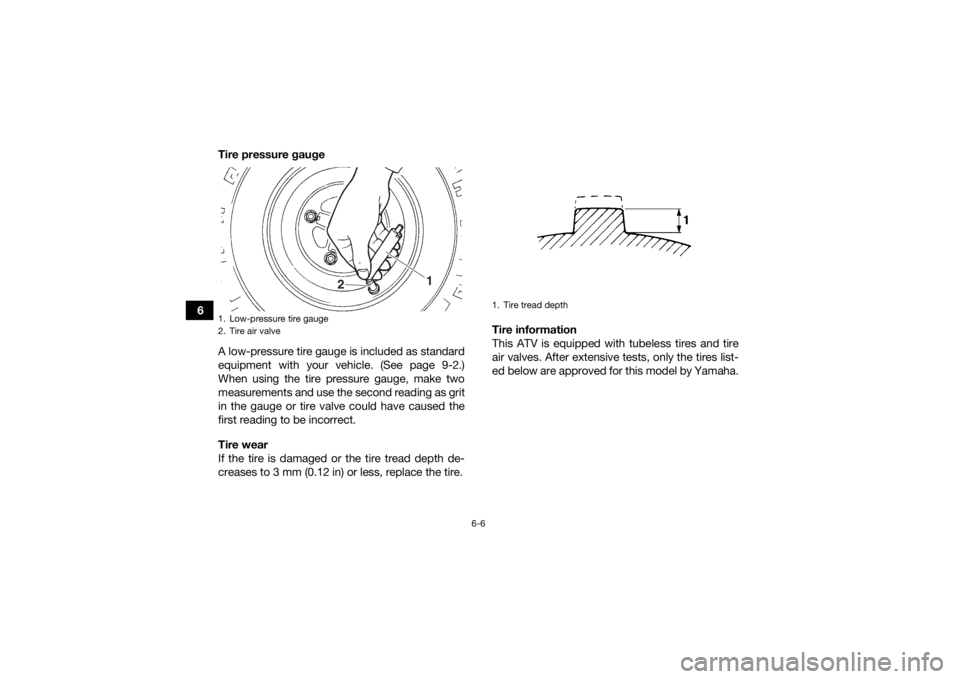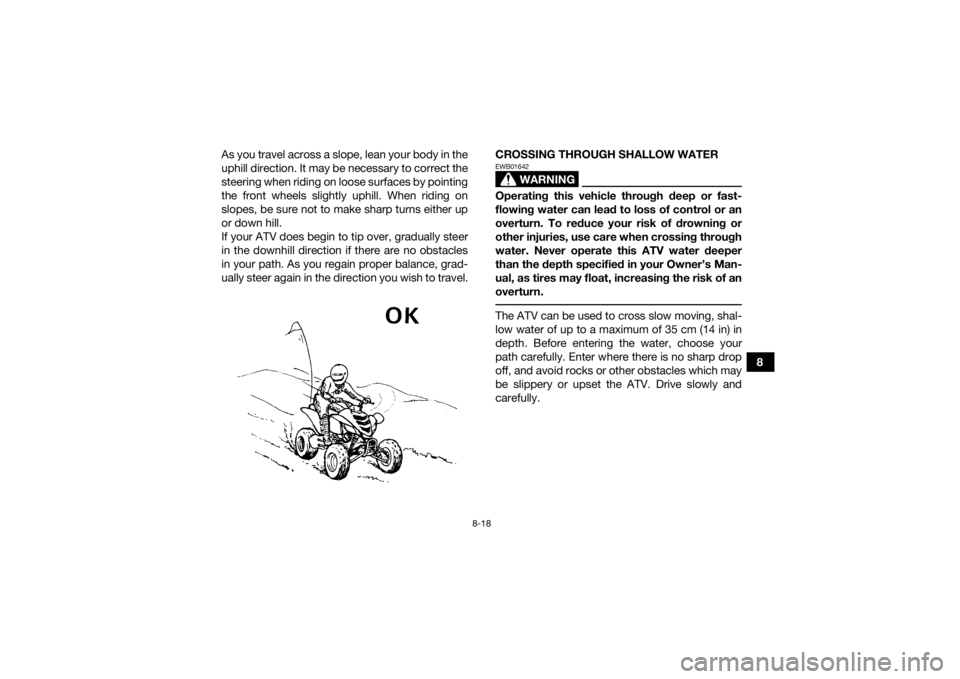tires YAMAHA YFM700R 2020 Owners Manual
[x] Cancel search | Manufacturer: YAMAHA, Model Year: 2020, Model line: YFM700R, Model: YAMAHA YFM700R 2020Pages: 156, PDF Size: 4.19 MB
Page 9 of 156

Throttle lever ............................................... 6-5
Drive chain .................................................. 6-5
Tires ............................................................ 6-5
Chassis fasteners........................................ 6-7
Instruments, lights and switches ................ 6-7
OPERATION ................................................... 7-1 Starting the engine ...................................... 7-1
Shifting ........................................................ 7-2
Operating the reverse knob and driving in reverse ...................................................... 7-4
Engine break-in ........................................... 7-5
Parking ........................................................ 7-5
Parking on a slope ...................................... 7-6
Accessories and loading ............................. 7-6
RIDING YOUR ATV ........................................ 8-1 GETTING TO KNOW YOUR ATV ................ 8-2
RIDE WITH CARE AND GOOD JUDGMENT .............................................. 8-2
BE CAREFUL WHERE YOU RIDE ............... 8-8
TURNING YOUR ATV................................ 8-11
CLIMBING UPHILL ................................... 8-13
RIDING DOWNHILL .................................. 8-16
CROSSING A SLOPE................................ 8-17
CROSSING THROUGH SHALLOW WATER .................................................... 8-18 RIDING OVER ROUGH TERRAIN ............. 8-20
SLIDING AND SKIDDING ......................... 8-20
WHAT TO DO IF... .................................... 8-21
PERIODIC MAINTENANCE AND
ADJUSTMENT ............................................... 9-1 Owner’s Manual and tool kit....................... 9-2
Periodic maintenance chart: Emission control system .......................................... 9-3
Periodic maintenance chart: General maintenance and lubrication .................... 9-5
Removing and installing the panel............ 9-10
Checking the spark plug........................... 9-10
Engine oil and oil filter element................. 9-13
Why Yamalube ......................................... 9-18
Coolant ..................................................... 9-18
Cleaning the air filter element ................... 9-22
Cleaning the spark arrester ...................... 9-26
Adjusting the engine idling speed ............ 9-28
Adjusting the throttle lever free play ......... 9-29
Valve clearance......................................... 9-29
Adjusting the reverse lock release cable ....................................................... 9-30
Brakes....................................................... 9-30
Checking the front and rear brake pads... 9-30
Checking the brake fluid level .................. 9-31
Changing the brake fluid .......................... 9-34
UBCX60E0.book Page 2 Friday, April 19, 2019 9:09 AM
Page 17 of 156

2-5
2
E10E5
**.* kPa
*.** kgf/cm²
*.* psi **.* kPa
*.** kgf/cm²
*.* psi
This unit contains high-pressure nitrogen
gas.
Mishandling can cause an explosion. Do not
incinerate, puncture or open.
EN228 fuel identification mark.
Gasoline of ethanol 10% or less can be
used. EN228 fuel identification mark.
Gasoline of ethanol 5% or less can be used.
Use unleaded gasoline only. Measure the tire pressure when the tires are
cold.
Adjust the tire pressure.
Improper tire pressure can cause loss of
control.
Loss of control can result in severe injury or
death.
UBCX60E0.book Page 5 Friday, April 19, 2019 9:09 AM
Page 20 of 156

3-3
3technique described in this manual on level
ground. Avoid crossing the side of a steep hill if
possible.
Always use proper procedures if you stall or roll
backwards when climbing a hill. To avoid stall-
ing, use the proper gear and maintain a steady
speed when climbing a hill. If you stall or roll
backwards, follow the special procedure for
braking described in this manual. Dismount on
the uphill side or to a side if pointed straight up-
hill. Turn the ATV around and remount, following
the procedure described in this manual.
Always check for obstacles before operating in
a new area.
Never attempt to operate over large obstacles,
such as large rocks or fallen trees. Always follow
proper procedures when operating over obsta-
cles as described in this manual.
Always be careful when skidding or sliding.
Learn to safely control skidding or sliding by
practicing at low speeds and on level, smooth
terrain. On extremely slippery surfaces, such as
ice, go slowly and be very cautious in order to
reduce the chance of skidding or sliding out of
control.
Never operate an ATV in fast flowing water or in
water deeper than that recommended in this
manual. Remember that wet brakes may have
reduced stopping ability. Test your brakes after
leaving water. If necessary, apply them several
times to let friction dry out the linings.
Always be sure there are no obstacles or people
behind you when you operate in reverse. When
it is safe to proceed in reverse, go slowly.
Always use the size and type of tires specified in
this manual.
Always maintain proper tire pressure as de-
scribed in this manual.
Never exceed the stated load capacity for an
ATV. Cargo should be properly distributed and
securely attached. Reduce speed and follow in-
structions in this manual for carrying cargo or
pulling a trailer. Allow greater distance for brak-
ing.
Do not operate your ATV during darkness un-
less it is equipped with a properly functioning
headlight. Off-road riding is inherently danger-
ous and additionally, off-road trails do not have
streetlights to guide you.
UBCX60E0.book Page 3 Friday, April 19, 2019 9:09 AM
Page 52 of 156

6-2
6
Front brake• Check operation. If soft or spongy, have Yamaha dealer bleed hy-
draulic system.
• Check brake pads for wear, and replace if necessary.
• Check brake fluid level in reservoir, and add specified brake fluid to specified level if necessary.
• Check hydraulic system for leakage. Correct if necessary. 6-4, 9-30, 9-31, 9-35
Rear brake • Check operation. If soft or spongy, have Yamaha dealer bleed hy-
draulic system.
• Check brake pads for wear, and replace if necessary.
• Check brake fluid level in reservoir, and add specified brake fluid to specified level if necessary.
• Check hydraulic system for leakage. Correct if necessary. 6-4, 9-30, 9-31, 9-35
Clutch • Check operation, and correct if necessary.
• Lubricate cable if necessary.
• Check lever free play, and adjust if necessary. 9-38
Throttle lever • Make sure that operation is smooth. Lubricate cable and lever
housing if necessary.
• Check lever free play, and adjust if necessary. 6-5, 9-29
Control cables • Make sure that operation is smooth. Lubricate if necessary. 9-42
Drive chain • Check chain slack, and adjust if necessary.
• Check chain condition. Lubricate if necessary. 6-5, 9-39, 9-41
Wheels and tires • Check wheel condition, and replace if damaged.
• Check tire condition and tread depth. Replace if necessary.
• Check air pressure. Correct if necessary. 6-5
Shift pedal • Make sure that operation is smooth.
• Correct if necessary.
9-43
Brake pedal • Make sure that operation is smooth. Lubricate pedal pivoting point
if necessary. 9-43
ITEM ROUTINE PAGEUBCX60E0.book Page 2 Friday, April 19, 2019 9:09 AM
Page 55 of 156

6-5
6
Brake operation
Test the brakes at slow speed after starting out to
make sure they are working properly. If the brakes
do not provide proper braking performance,
check the brake pads for wear. (See page 9-30.)
EBU19762Throttle leverCheck the operation of the throttle lever. It must
open smoothly and spring back to the idle position
when released. Have a Yamaha dealer correct if
necessary.EBU19771Drive chainCheck the condition of the drive chain and check
the drive chain slack. Lubricate and adjust the
drive chain as necessary. (See page 9-39.)EBU19799TiresCheck tire pressure regularly to make sure it is at
the recommended specifications. Also check for
wear and damage. Tire pressure
Use a tire pressure gauge to check and adjust tire
air pressure when the tires are cold. The tire air
pressure must be equal on both sides.
WARNING! Operation of this vehicle with im- proper tire pressure may cause severe injury or
death from loss of control or rollover. Tire
pressure below the minimum specified could
also cause the tire to dislodge from the rim un-
der severe riding conditions.
[EWB02542]
Recommended tire pressure: Front27.5 kPa (0.275 kgf/cm², 4.0 psi)
Rear 27.5 kPa (0.275 kgf/cm², 4.0 psi)
Minimum tire pressure: Front24.5 kPa (0.245 kgf/cm², 3.6 psi)
Rear 24.5 kPa (0.245 kgf/cm², 3.6 psi)
Maximum tire seating pressure: Front250 kPa (2.5 kgf/cm², 36 psi)
Rear 250 kPa (2.5 kgf/cm², 36 psi)
UBCX60E0.book Page 5 Friday, April 19, 2019 9:09 AM
Page 56 of 156

6-6
6Tire pressure gauge
A low-pressure tire gauge is included as standard
equipment with your vehicle. (See page 9-2.)
When using the tire pressure gauge, make two
measurements and use the second reading as grit
in the gauge or tire valve could have caused the
first reading to be incorrect.
Tire wear
If the tire is damaged or the tire tread depth de-
creases to 3 mm (0.12 in) or less, replace the tire.
Tire information
This ATV is equipped with tubeless tires and tire
air valves. After extensive tests, only the tires list-
ed below are approved for this model by Yamaha.
1. Low-pressure tire gauge
2. Tire air valve
1
2
1. Tire tread depth
UBCX60E0.book Page 6 Friday, April 19, 2019 9:09 AM
Page 57 of 156

6-7
6
Aftermarket tires and rims
The tires and rims that came with your ATV were
designed to match the performance capabilities
and to provide the best combination of handling,
braking, and comfort. Other tires, rims, sizes, and
combinations may not be appropriate.
WARNING
EWB02552Use of improper tires on this ATV may cause
loss of control, increasing your risk of an acci-
dent.
EBU19841Chassis fastenersMake sure that all nuts, bolts and screws are
properly tightened.EBU19851Instruments, lights and switchesCheck that all instruments, lights and switches are
working properly. Correct if necessary.
Front:
Manufacturer/model:MAXXIS/MS13
Size: AT22 x 7-10
Rear: Manufacturer/model:MAXXIS/M976Y
Size: AT20 x 10-9
UBCX60E0.book Page 7 Friday, April 19, 2019 9:09 AM
Page 60 of 156

7-3
74. Open the throttle gradually and at the same
time, release the clutch lever slowly.
WARNING! Opening the throttle abruptly
or releasing the clutch lever too quickly
could make the ATV wheelie, which would
increase the chance of an accident, in-
cluding an overturn.
[EWB00732]
5. Once the ATV has attained adequate speed,release the throttle, and at the same time,
quickly pull in the clutch lever.
6. Shift the transmission into second gear. (Make sure not to shift the transmission into
neutral.)
7. Open the throttle part way and gradually re- lease the clutch lever.
8. Follow the same procedure when shifting to the next higher gear.EBU20653To decelerate
When slowing down or stopping, release the
throttle and apply the brakes smoothly and evenly.
As you slow down, shift to a lower gear. Be sure
that the engine has sufficiently slowed before en-
gaging a lower gear. Improper use of the brakes or shifting can cause the tires to lose traction, reduc-
ing control and increasing the possibility of an ac-
cident.
WARNING
EWB00712Make sure the engine has sufficiently slowed
before shifting to a lower gear. Engaging a low-
er gear when the engine speed is too high
could make the wheels stop rotating and lose
traction. This could cause loss of control, an
accident and injury. It could also cause engine
or drivetrain damage. NOTICEECB00181
Even with the transmission in the neutral po-
sition, do not coast for long periods of time
with the engine off, and do not tow the ATV
for long distances. The transmission is prop-
erly lubricated only when the engine is run-
ning. Inadequate lubrication may damage
the transmission.
UBCX60E0.book Page 3 Friday, April 19, 2019 9:09 AM
Page 76 of 156

8-11
8Select a large, flat, unpaved area to become famil-
iar with your ATV. Make sure that this area is free
of obstacles and other riders. You should practice
control of the throttle, brakes, shifting procedures,
and turning techniques in this area before trying
more difficult terrain.
Set the parking brake and follow the instruction on
page 7-1 to start the engine. Once it has warmed
up you are ready to begin riding your ATV. As you
get on the ATV, be sure not to accidentally move
the shift pedal. With the engine idling, pull the
clutch lever to disengage the clutch and shift into
1st gear, and then release the parking brake.
Open the throttle gradually, and at the same time,
release the clutch lever slowly. Once the ATV has
attained adequate speed, release the throttle lever
and at the same time, quickly pull in the clutch le-
ver and shift into 2nd gear. Open the throttle part
way and gradually release the clutch.
WARNING!
If the throttle is applied too abruptly or if the
throttle is not released during shifting, or if the
shift pedal is not released before applying the
throttle, the front wheels may lift off the
ground, resulting in a loss of directional con- trol.
[EWB02632]
NOTICE: Do not shift gears without
releasing the throttle. Damage to the engine or
drive train may occur.
[ECB01072]
Use this same procedure as you move into the
higher gears. Be sure to coordinate the use of the
throttle and shift pedal properly.
Avoid higher speeds until you are thoroughly fa-
miliar with the operation of your ATV.
When slowing down or stopping, release the
throttle and apply the brakes smoothly and evenly.
As you slow down, shift to a lower gear. Be sure
that the engine has sufficiently slowed before en-
gaging a lower gear. Improper use of the brakes or
shifting can cause the tires to lose traction, reduc-
ing control and increasing the possibility of an ac-
cident.
TURNING YOUR ATV
WARNING
EWB01772Always follow proper procedures for turning as
described in this Owner’s Manual. Practice
turning at low speeds before attempting to turn
at faster speeds. Do not turn at speeds too fast
for your skills or the conditions. ATV could go
out of control, causing a collision or overturn.
UBCX60E0.book Page 11 Friday, April 19, 2019 9:09 AM
Page 83 of 156

8-18
8
As you travel across a slope, lean your body in the
uphill direction. It may be necessary to correct the
steering when riding on loose surfaces by pointing
the front wheels slightly uphill. When riding on
slopes, be sure not to make sharp turns either up
or down hill.
If your ATV does begin to tip over, gradually steer
in the downhill direction if there are no obstacles
in your path. As you regain proper balance, grad-
ually steer again in the direction you wish to travel.
CROSSING THROUGH SHALLOW WATER
WARNING
EWB01642Operating this vehicle through deep or fast-
flowing water can lead to loss of control or an
overturn. To reduce your risk of drowning or
other injuries, use care when crossing through
water. Never operate this ATV water deeper
than the depth specified in your Owner’s Man-
ual, as tires may float, increasing the risk of an
overturn. The ATV can be used to cross slow moving, shal-
low water of up to a maximum of 35 cm (14 in) in
depth. Before entering the water, choose your
path carefully. Enter where there is no sharp drop
off, and avoid rocks or other obstacles which may
be slippery or upset the ATV. Drive slowly and
carefully.
UBCX60E0.book Page 18 Friday, April 19, 2019 9:09 AM